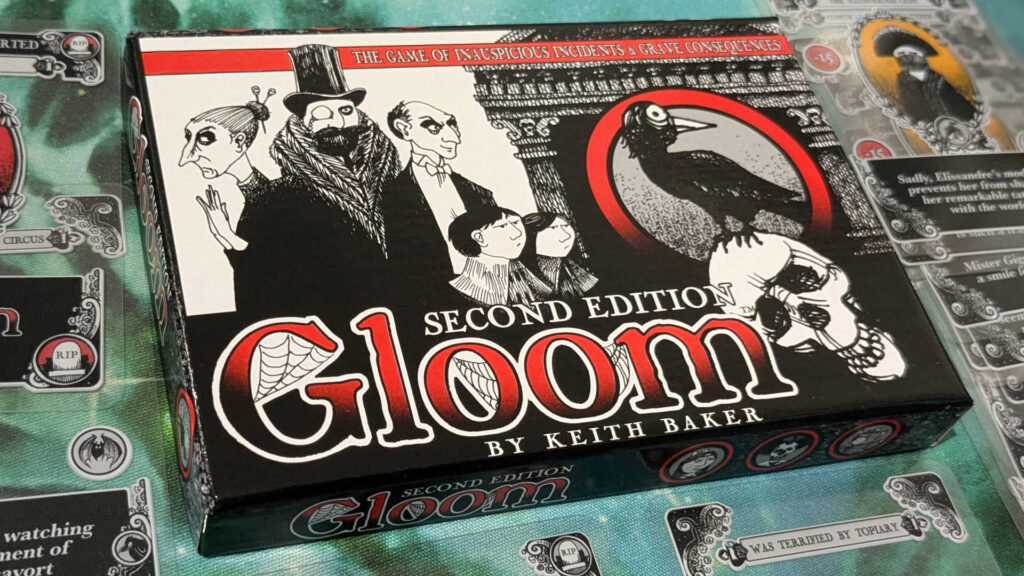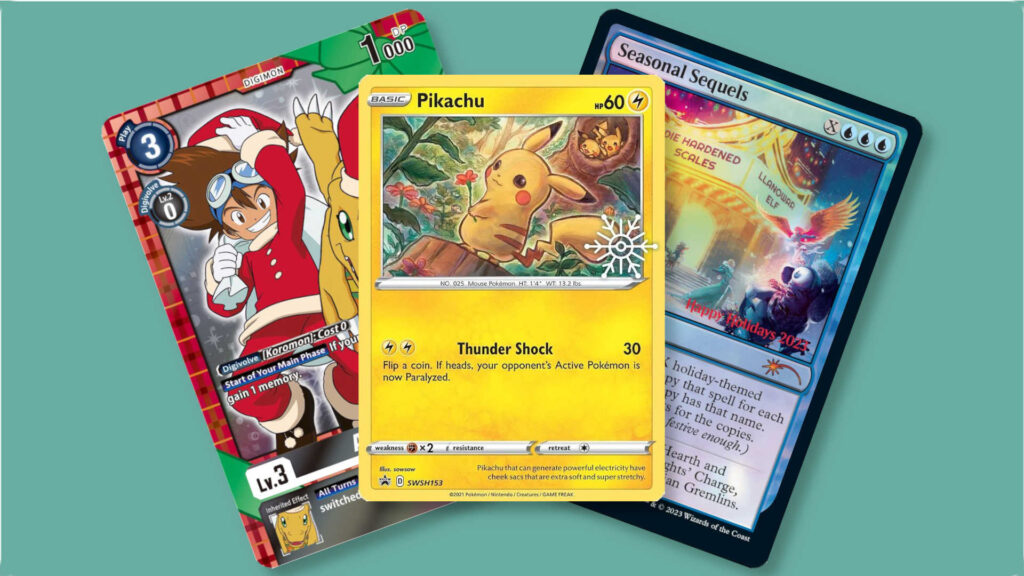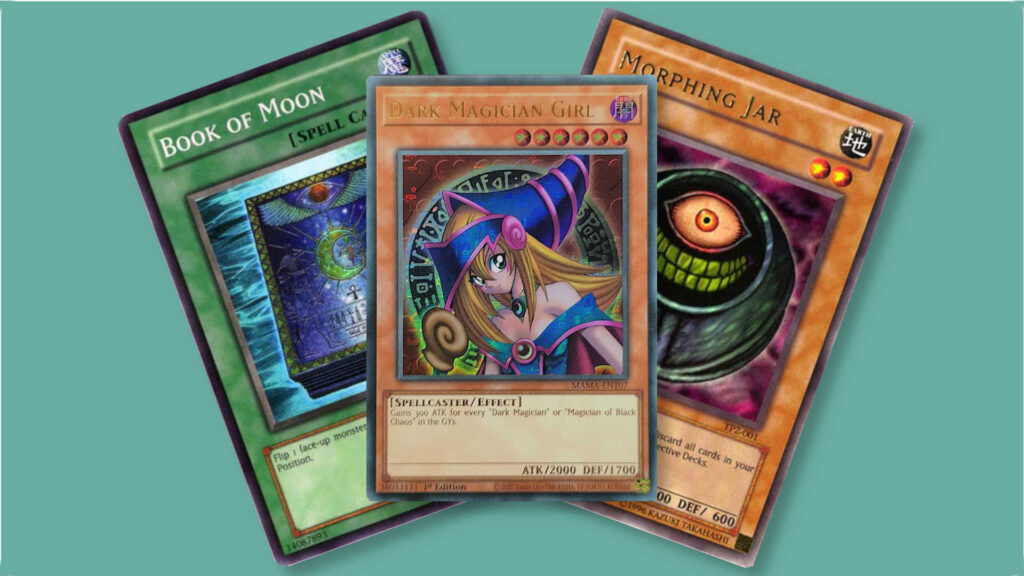First released two decades ago, Gloom is a card game in which players compete to have the saddest family members at the end of the game. The player whose family members have the lowest total of Self-Worth Points (known as Pathos in earlier editions) wins; however, only the Self-Worth Points on dead family members will count towards the final total. If that sounds a bit too grim for you, fear not; Gloom has a rich vein of dark humor throughout, with witty card text and cartoonish, caricatured Gothic artwork in the style of illustrators such as Edward Gorey, Charles Addams, or Tim Burton.
This Second Edition of the game, released in 2014, only has minimal differences to the first. Is it worth checking out this edition, and is Gloom worth playing in general? Let’s find out!
Table of Contents
ToggleGetting Started With Gloom
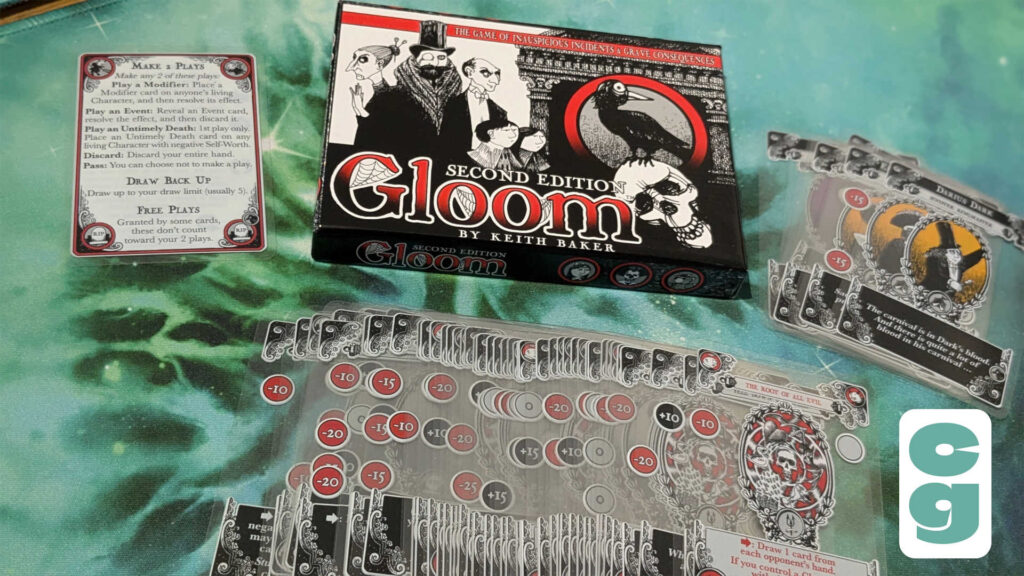
A neat little box of cards, the black, white, and red aesthetic of the packaging gives Gloom an immediately striking look; the choice of colors and Gothic cartoon art is brilliant. The Second Edition’s box is slightly different to the older versions of the game, some of which came with a tuckbox style, rather than the lid-and-tray, two-piece design of the current edition (ours felt a bit stiff and it didn’t open particularly easily, but over time that should be less of an issue). A few very minor changes have been made to the box’s overall design, but you’d have to look really hard to notice them. After all, if it ain’t broke, don’t fix it!
Though there are several expansions available for Gloom, all you’ll need to get started with the game is the Second Edition box itself, which contains 110 cards (of course, if you get hold of the original edition, that will be fine too!). The cards themselves are also very striking in terms of their design; not only does that same dark humor and illustration style carry over to every visual element of the cards, but you’ll also immediately notice something very special about them: they’re transparent, and you’ll see why this is necessary as we cover the rules of the game.
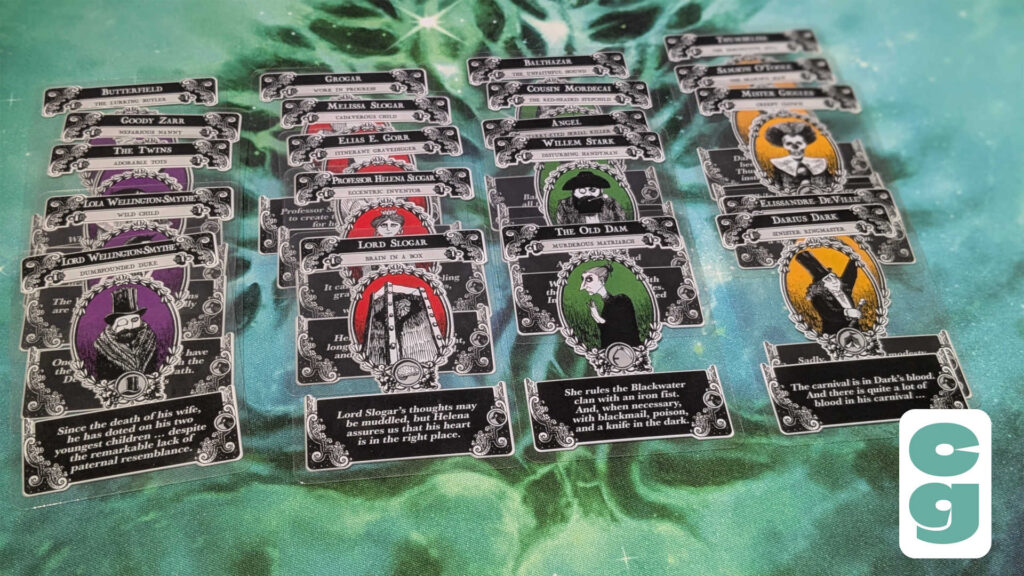
Setup is incredibly straightforward: separate the four families and two reference cards from the rest of the deck, which you then shuffle to form the draw deck. Each player takes a family of their choice (the families are color coded, as well as having their own family symbol), draws five cards to form a starting hand, and then play begins. As a further example of the humor woven into the mechanics of Gloom, the first player will be the player who’s had the worst day!
How to Play Gloom
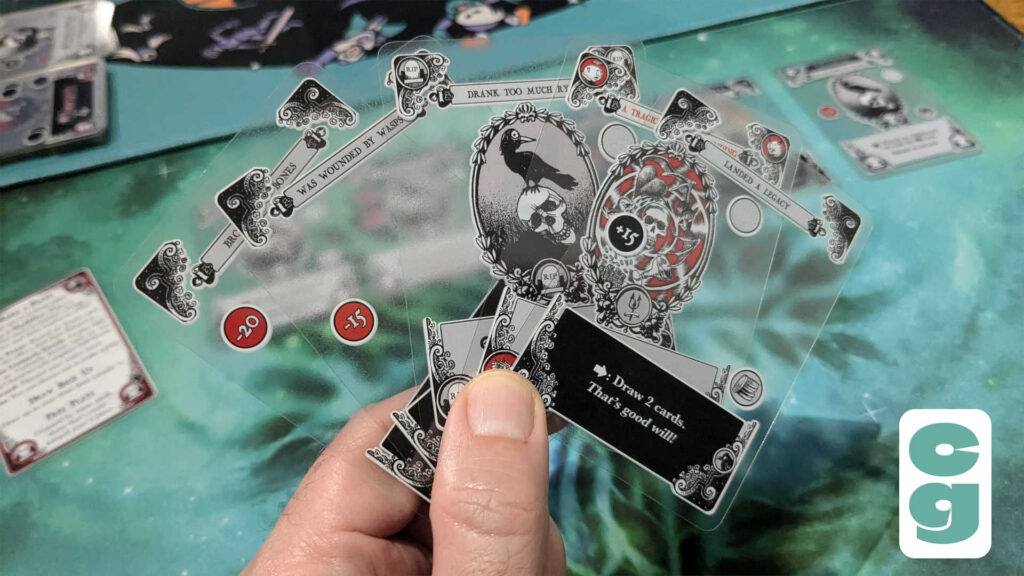
On each turn, players will take two actions from among these options: they can play a Modifier on a living Character card (either on their own, or someone else’s), play an Event, play an Untimely Death (which must be done as their first action, unless another card effect allows otherwise, and can only be played on a Character with negative Self-Worth), discard their entire hand, or pass. The same play can be made twice, except Untimely Deaths, and once both actions have been taken, the player draws cards up to their draw limit (the default hand size is five cards, but this can be altered by effects on cards still in play), then play passes to the next player.
Playing Modifiers
In general, you’ll want to play Modifier cards with negative points on your Characters, and those with positive points on opponents’ Characters. This isn’t always the case, as some card effects on negative cards may cause an opponent to lose a turn, or discard their hand, or both; the effect of a card is enacted by the owner of the Character it’s played on, which isn’t always the person who played the card.

When you place a Modifier on a Character, it may cover up one or more point values or symbols; only the visible points and symbols count for scoring purposes, or when determining if a Character has negative Self-Worth. For example, when playing the Was Greeted by Ghosts card on Mister Giggles, as shown above, you’ll give the Character -30 Self-Worth points and a skull symbol. You must also follow the effect, which states that you must discard three cards from your hand when this Modifier is played.
As you can see from the card played on Mister Giggles, each Modifier has flavor text in its title, which name the event (almost all alliterative, such as Pursued by Poodles, Sickened by Salmon, or Slept Without Sorrows; the latter of which is a positive Modifier) that’s caused the change in a Character’s Self-Worth. This element is where most of the fun can be had in Gloom, as the rules actively encourage players to create stories about the circumstances which led to the Modifier situation taking place. They can be highly thematic, such as the time that I managed to get the tiny opera singer, Thumbelisa, menaced by mice, or just plain left-field, such as getting creepy clown Mister Giggles trapped on a train.
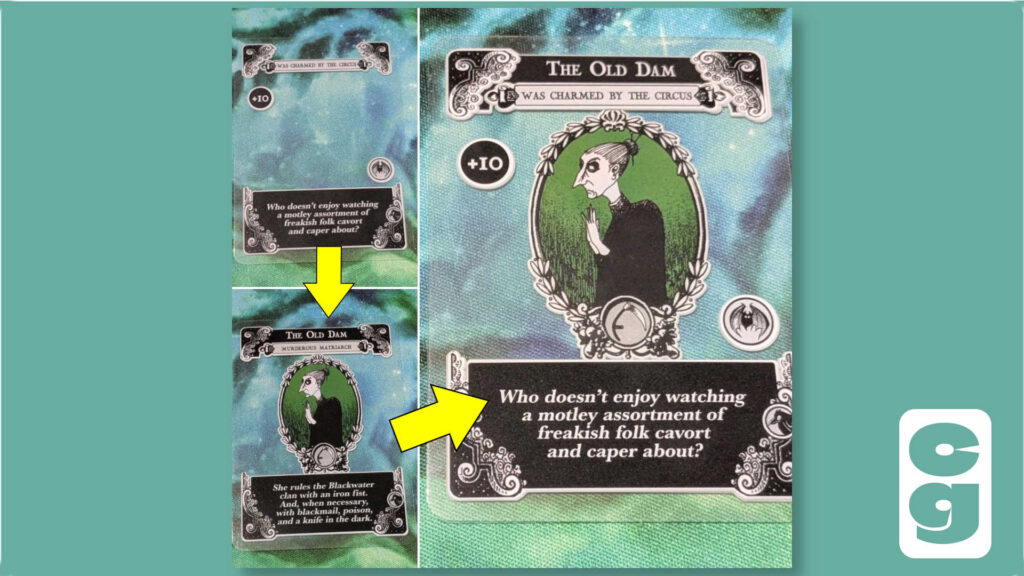
Either way, it’s great fun to come up with the details of what leads to each successive tragedy, or even the rare, pleasant occurrences that lead to positive values (one example given above, with the Was Charmed by the Circus Modifier card) and give your misanthropic Characters a brief respite from the overwhelming (yet still amusing, to the players at least) bleakness of their lives.
It’s worth noting that a card or two have had their wording changed between editions; though the humor in the game is pretty dark, it’s not intended to be offensive or insensitive, and there was at least one card detailing an event which had, perhaps, somewhat ableist language, and that’s now been amended. Nothing has been lost in the removal of this language, and it only serves to make Gloom more inclusive and modern, despite its old school aesthetic.
Playing Event Cards
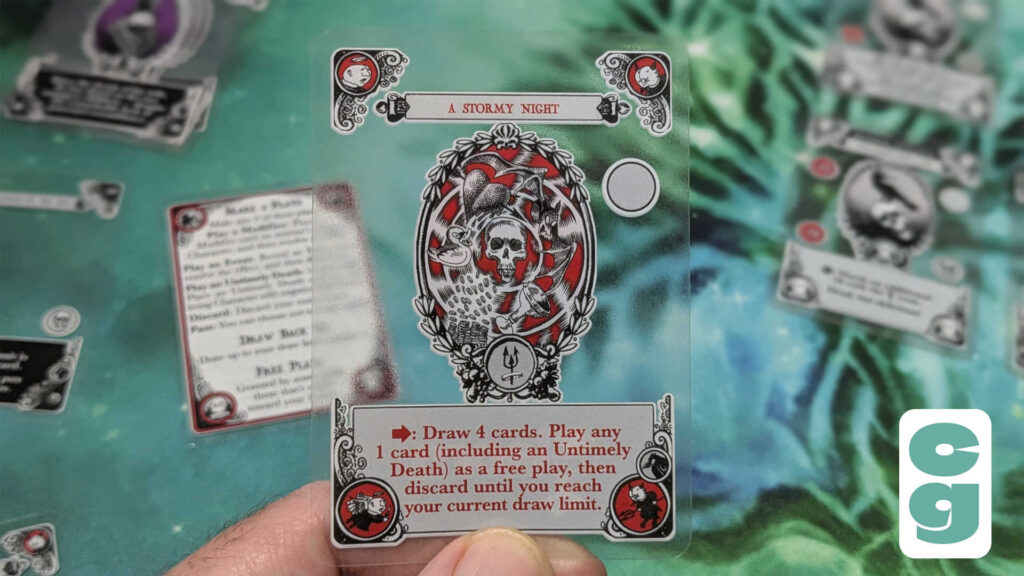
Events are one-time effects, which are played, the instructions on the card followed, then discarded. These, and other cards, have perhaps the most notable difference between the earlier printings and the Second Edition, in that they have icons which illustrate the type of effect.
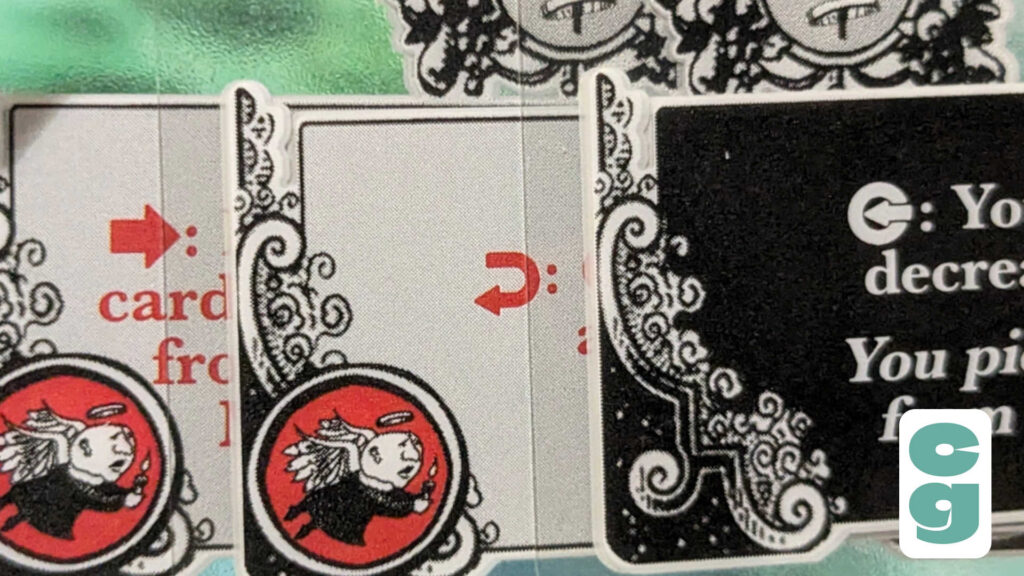
For instance, an immediate effect has an arrow pointing right, a response (which can be played on an opponent’s turn, in response to their card being played) has an arrow going clockwise, and continuous effects have an arrow pointing left, in a circle. The rules also show a persistent card effect symbol, but this is only present in Gloom’s expansions.
Untimely Death Cards
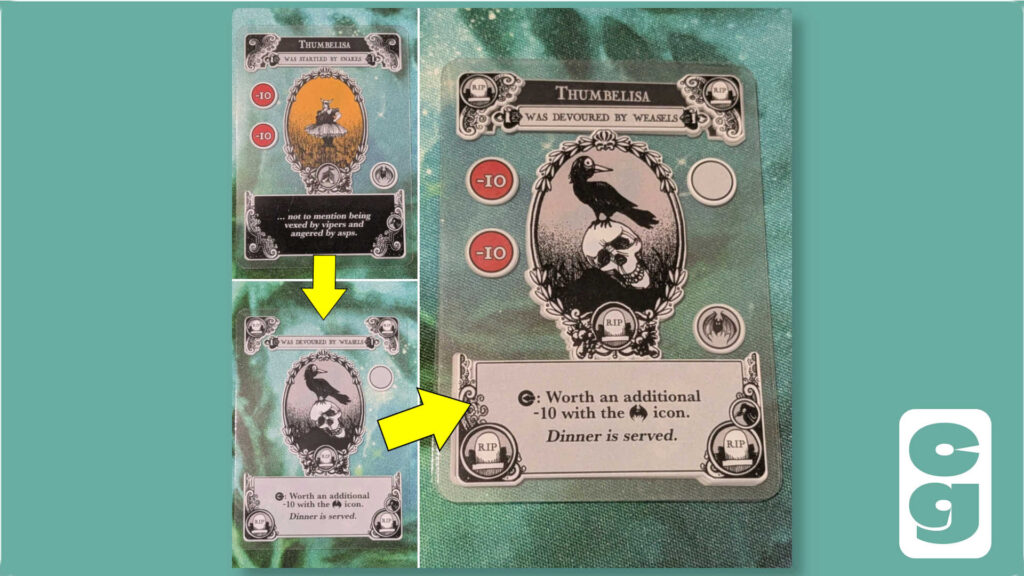
Once a Character has negative Self-Worth, thanks to Modifier cards being played on them, players can play an Untimely Death on that Character (as demonstrated above). A dead Character can no longer be modified, and its points are the total of any visible values, plus any bonus which may be on the Untimely Death card. The Thumbelisa Character card shown above, which has the Was Startled by Snakes Modifier, when it has the Untimely Death card Was Devoured by Weasels, is worth -30 Self-Worth points. That’s two -10 point values which aren’t covered up, along with the symbol bonus of -10 from the Untimely Death itself, as the symbol matches with the one on Was Startled by Snakes. As with Modifiers, players are encouraged to describe what exactly led to the unfortunate Character’s demise, with the Untimely Death card’s title, as you can see, having a brief summary of the incident, which players can elaborate on.
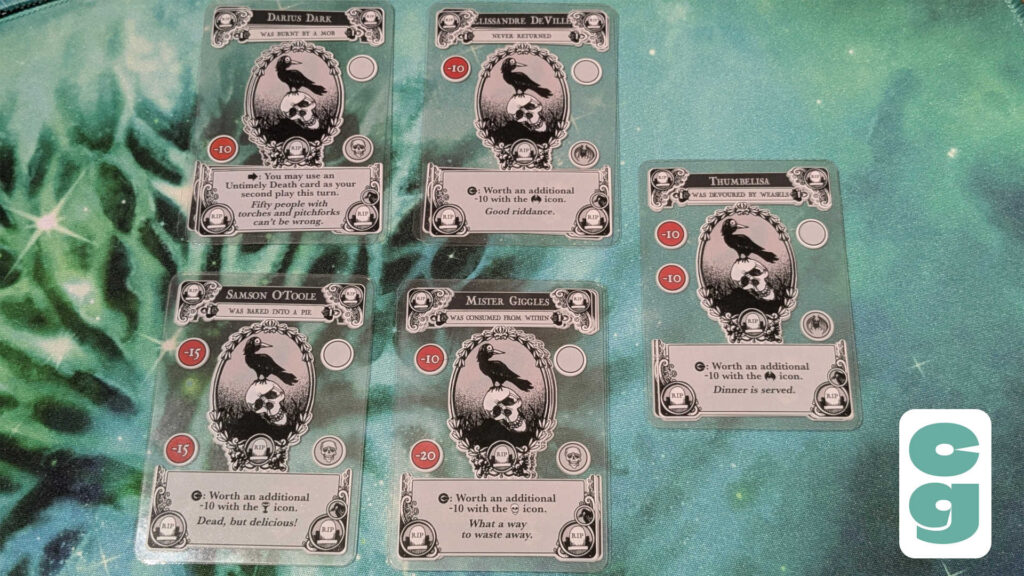
Once the final Character of any family has died (you can see a family of Characters who have all died above), play immediately ends and the points on all dead Characters are calculated. The family with the lowest family value of Self-Worth points wins the game.
Is Gloom Fun to Play?
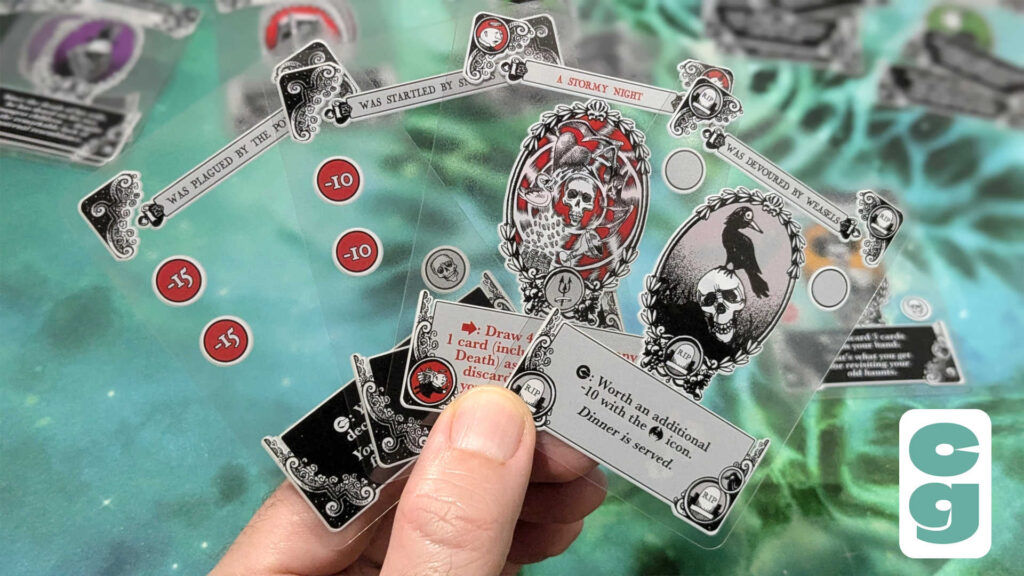
A deceptively simple game, Gloom can actually be a lot more strategic and filled with interesting decisions than it may seem at first glance. It’s incredibly easy to learn, but its interesting mechanics and amusing (if morbid) theme really set it apart from card games which aim for a similarly straightforward set of rules, yet can often be a little too chaotic to be enjoyable. For example, games such as Unstable Unicorns and Exploding Kittens both have similarly dark humor, but their general design is a little too light and can often feel much less satisfying, even frustratingly out of the players’ hands, as a result. Gloom is a much more robustly designed game which should appeal to a wider spectrum of gamers.
Though not all players will necessarily want to take advantage of the storytelling opportunities the game provides, this is another aspect of Gloom that makes it so appealing. Players who don’t get into the spirit of this aspect of the game can often feel underwhelmed by Gloom, as ignoring the storytelling can make the card play a little too mechanical and dry.
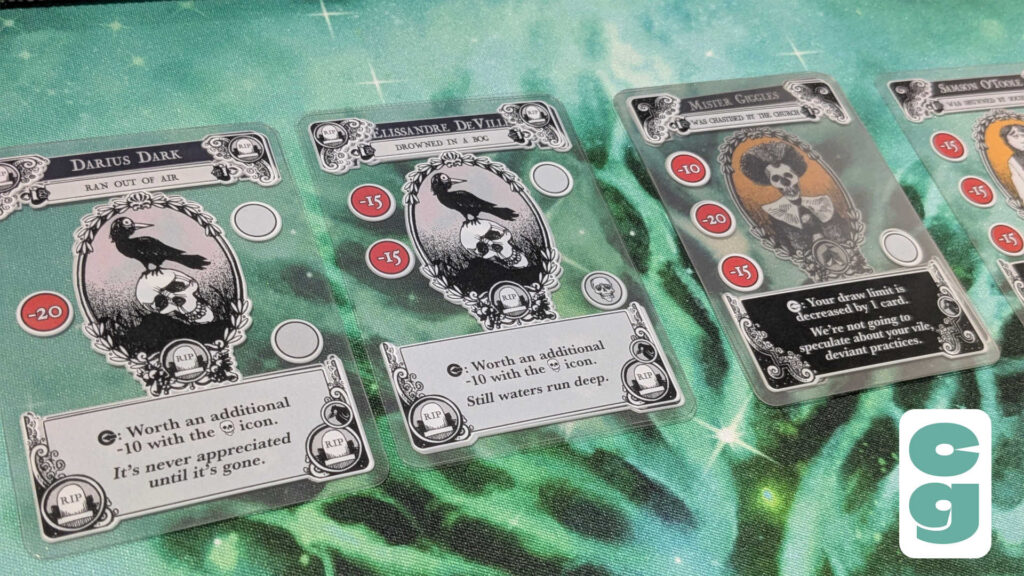
However, played as intended, with players all actively participating in the tragic events of their families, Gloom is as good a “party” style game as can be. It’s also worth noting that, as long as the dark humor isn’t too morbid for any younger players who may want to join, it’s a game that can be enjoyed by gamers of just about any age or experience level. In terms of Gloom’s general tone and even its Gothic aesthetic, think something along the lines of Lemony Snicket’s A Series of Unfortunate Events book series, which do cover some fairly dark subject matter, albeit in a kid-friendly way.
It’s worth noting that the humor may not last through a multitude of plays, given that the same disasters which befall the Characters will, naturally, keep coming up. However, mixing the number of players, and who you play with, can certainly still keep Gloom fresh for a little while. Given this concern about the entertainment value’s potential longevity issues, it’s well worth noting that numerous expansions for Gloom can be added into the game in various combinations, bringing new mechanics and flavor to the game as and when needed, or desired. Themed editions of Gloom also exist, such as Cthulhu Gloom, Gloom in Space, or Fairytale Gloom, to name a few; though also standalone games, these can be combined with other expansions too, thus extending the appeal and longevity of the core game.
The Card Gamer Verdict
The beautifully dark and moody aesthetic of Gloom gives it an immediately striking look, and its fun, morbidly humorous gameplay makes it a simple, party-style experience with the right group.
The transparent plastic cards in Gloom are another unique element that sets it apart, and the cards in this edition of the game feel pretty robust and consistent in their quality and overall design.
Even with all of the positives in mind, the humor of Gloom may wear thin over time, and it can feel a little dry if players don’t engage with the (optional) storytelling aspect of the game.
However, it’s a hilarious, clever, and somewhat unique experience when played as intended, with expansions readily available to expand and upgrade the experience if players start to feel repetition in Gloom Second Edition’s set of cards.
Want to check out other family-friendly card games? If Gloom appeals to you, you might also like the slightly warped humor of a game such as Doomlings. Or how about a more abstract title that packs a lot of fun into a reasonably sized box, such as Flip 7?


